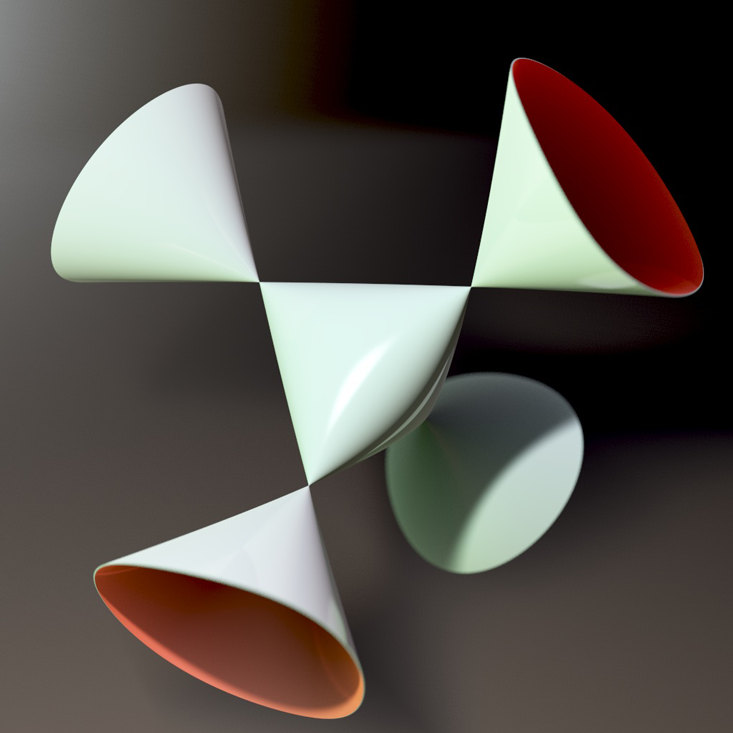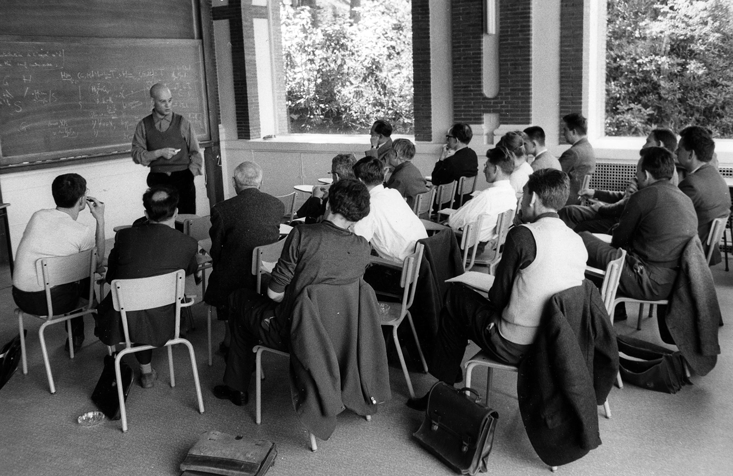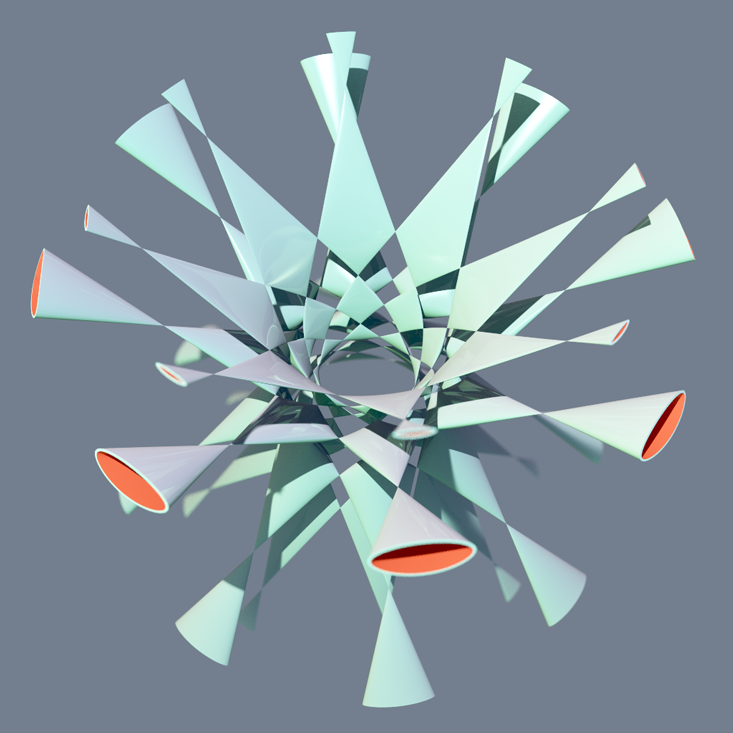In my 50s, too old to become a real expert, I have finally fallen in love with algebraic geometry. As the name suggests, this is the study of geometry using algebra. Around 1637, René Descartes laid the groundwork for this subject by taking a plane, mentally drawing a grid on it, as we now do with graph paper, and calling the coordinates x and y. We can write down an equation like x2+ y2 = 1, and there will be a curve consisting of points whose coordinates obey this equation. In this example, we get a circle!
It was a revolutionary idea at the time, because it let us systematically convert questions about geometry into questions about equations, which we can solve if we’re good enough at algebra. Some mathematicians spend their whole lives on this majestic subject. But I never really liked it much until recently—now that I’ve connected it to my interest in quantum physics.
If we can figure out how to reduce topology to algebra, it might help us formulate a theory of quantum gravity.
As a kid, I liked physics better than math. My uncle Albert Baez, father of the famous folk singer Joan Baez, worked for UNESCO, helping developing countries with physics education. My parents lived in Washington, D.C. Whenever my uncle came to town, he’d open his suitcase, pull out things like magnets or holograms, and use them to explain physics to me. This was fascinating. When I was 8, he gave me a copy of the college physics textbook he wrote. While I couldn’t understand it, I knew right away that I wanted to. I decided to become a physicist and my parents were a bit worried, because they knew physicists needed mathematics, and I didn’t seem very good at that. I found long division insufferably boring and refused to do my math homework, with its endless repetitive drills. But later, when I realized that by fiddling around with equations I could learn about the universe, I was hooked. The mysterious symbols seemed like magic spells. And in a way, they are. Science is the magic that actually works.
In college I majored in math, and became curious about theoretical physicist Eugene Wigner’s question about the “unreasonable effectiveness” of mathematics: Why should our universe be so readily governed by mathematical laws? As he put it, “The miracle of the appropriateness of the language of mathematics for the formulation of the laws of physics is a wonderful gift which we neither understand nor deserve.” As a youthful optimist, I felt these laws would give us a clue to the deeper puzzle: why the universe is governed by mathematical laws in the first place. I already knew that there was too much math to learn it all, so, in grad school, I tried to focus on what mattered to me. And one thing that did not matter to me was algebraic geometry.
How could any mathematician not fall in love with algebraic geometry? Here’s why: In its classic form, this subject considers only polynomial equations—equations that describe not just curves, but also higher-dimensional shapes called “varieties.” So, x2+ y2 = 1 is fine, and so is x43 – 2xy2 = y7, but an equation with sines or cosines, or other functions, is out of bounds—unless we can figure out how to convert it into an equation with just polynomials. As a graduate student, this seemed like a terrible limitation. After all, physics problems involve plenty of functions that aren’t polynomials.
Why does algebraic geometry restrict itself to polynomials? Mathematicians study all sorts of functions, but while they’re very important, at some level their complications are only a distraction from the fundamental mysteries of the relation between geometry and algebra. By restricting the breadth of their investigations, algebraic geometers can dig deeper into these mysteries. They’ve been doing this for centuries, and by now their mastery of polynomials is truly staggering: Algebraic geometry has grown into a powerful tool in number theory, cryptography, and many other subjects. But for its true devotees, it is an end in itself.
I once met a grad student at Harvard, and I asked him what he was studying. He said one word, in a portentous tone: “Hartshorne.” He meant Robin Hartshorne’s textbook Algebraic Geometry, published in 1977. Supposedly an introduction to the subject, it’s actually a very hard-hitting tome. Consider Wikipedia’s description:
The first chapter, titled “Varieties,” deals with the classical algebraic geometry of varieties over algebraically closed fields. This chapter uses many classical results in commutative algebra, including Hilbert’s Nullstellensatz, with the books by Atiyah–Macdonald, Matsumura, and Zariski–Samuel as usual references.
If you can’t make heads or tails of this … well, that’s exactly my point. To penetrate even the first chapter of Hartshorne, you need quite a bit of background. To read Hartshorne is to try to catch up with centuries of geniuses running as fast as they could.

One of these geniuses was Hartshorne’s thesis advisor, Alexander Grothendieck. From about 1960 to 1970, Grothendieck revolutionized algebraic geometry as part of an epic quest to prove the Weil Conjectures, which relate varieties to solutions of certain problems in number theory. Grothendieck guessed that the Weil Conjectures could be settled by strengthening and deepening the link between geometry and algebra. He had a concrete idea for how this should turn out. But making this idea precise required a huge amount of work. To carry it out, he started a seminar. He gave talks almost every day, and enlisted the help of some of the best mathematicians in Paris.

Working non-stop for a decade, they produced tens of thousands of pages of new mathematics, packed with mind-blowing concepts. In the end, using these ideas, Grothendieck succeeded in proving all the Weil Conjectures except the final, most challenging one. A student of his polished that one off, much to Grothendieck’s surprise.
During his most productive years, even though he dominated the French school of algebraic geometry, many mathematicians considered Grothendieck’s ideas “too abstract.” This sounds a bit strange, given how abstract all mathematics is. What’s inarguably true is that it takes time and work to absorb his ideas. As a grad student I steered clear of them, since I was busy struggling to learn physics: There, too, centuries of geniuses have been working full-speed, and anyone wanting to reach the cutting edge has a lot of catching up to do. But, later in my career, my research led me to Grothendieck’s work.
Had I taken a different path, I might have come to grips with his work through string theory. String theorists postulate that besides the visible dimensions of space and time—three of space and one of time—there are extra dimensions of space curled up too small to see. In some of their theories these extra dimensions form a variety. So, string theorists easily get pulled into sophisticated questions about algebraic geometry. And this, in turn, pulls them toward Grothendieck.

Indeed, some of the best advertisements for string theory are not successful predictions of experimental results—it’s made absolutely none of these—but rather, its ability to solve problems within pure mathematics, including algebraic geometry. For example, string theory is shockingly good at counting how many curves of different kinds you can draw on certain varieties. Thus, we now see string theorists talking with algebraic geometers, each able to surprise the other with their insights.
My own interest in Grothendieck’s work had a different source. I’ve always had serious doubts about string theory, and counting curves on varieties is the last thing I’d ever try: Like rock climbing, it’s exciting to watch but too scary to actually attempt it myself. It turns out that Grothendieck’s ideas are so general and powerful that they spill out beyond algebraic geometry into many other subjects. In particular, his 600-page unpublished manuscript Pursuing Stacks, written in 1983, made a big impression on me. In it, he argued that topology—very loosely, the theory of what space can be shaped like, if we don’t care about bending or stretching it, just what kind of holes it has—can be completely reduced to algebra!
At first this idea may sound just like algebraic geometry, where we use algebra to describe geometrical shapes, like curves or higher-dimensional varieties. But “algebraic topology” winds up having a very different flavor, because in topology we don’t restrict our shapes to be described by polynomial equations. Instead of dealing with beautiful gems, we’re dealing with floppy, flexible blobs—so the kind of algebra we need is different.
Algebraic topology is a beautiful subject that has been around long before Grothendieck—but he was one of the first to seriously propose a method to reduce all topology to algebra. Thanks to my work on physics, his proposal was tremendously exciting when I came across it. Here’s why: At the time I had taken up the challenge of trying to unify our two best theories of physics: quantum physics, which describes all the forces except gravity, and general relativity, which describes gravity. It seems that until we do this, our understanding of the fundamental laws of physics is doomed to be incomplete. But it’s devilishly difficult. One reason is that quantum physics is based on algebra, while general relativity involves a lot of topology. But that suggests an avenue of attack: If we can figure out how to reduce topology to algebra, it might help us formulate a theory of quantum gravity.
My physics colleagues will let out a howl here, and complain that I am oversimplifying. Yes, I’m oversimplifying: There is more to quantum physics than mere algebra, and more to general relativity than mere topology. Nonetheless, the possible benefits to physics of reducing topology to algebra are what got me so excited about Grothendieck’s work.
So, starting in the 1990s, I tried to understand the powerful abstract concepts that Grothendieck had invented—and by now I have partially succeeded. Some mathematicians find these concepts to be the hard part of algebraic geometry. They now seem like the easy part to me. The hard part, for me, is not these abstract concepts but the nitty-gritty details. First, there is all the material in those texts that Hartshorne takes as prerequisites: “the books by Atiyah–Macdonald, Matsumura, and Zariski–Samuel”—in short, piles and piles of algebra. But there is also a lot more.
The mysterious symbols seemed like magic spells. And in a way, they are. Science is the magic that actually works.
So, while I now have some of what it takes to read Hartshorne, until recently I was too intimidated to learn it. A student of physics once asked a famous expert how much mathematics a physicist needs to know. The expert replied: “More.” Indeed, the job of learning mathematics is never done, so I focus on the things that seem most important and/or fun. Until last year, algebraic geometry never rose to the top of the list.
What changed? I realized that algebraic geometry is connected to the relation between classical and quantum physics. Classical physics is the physics of Newton, where we imagine that we can measure everything with complete precision, at least in principle. Quantum physics is the physics of Schrödinger and Heisenberg, governed by the uncertainty principle: If we measure some aspects of a physical system with complete precision, others must remain undetermined.
For example, any spinning object has an “angular momentum.” In classical mechanics we visualize this as an arrow pointing along the axis of rotation, whose length is proportional to how fast the object is spinning. And in classical mechanics, we assume we can measure this arrow precisely. In quantum mechanics—a more accurate description of reality—this turns out not to be true. For example, if we know how far this arrow points in the x direction, we cannot know how far it points in the y direction. This uncertainty is too small to be noticeable for a spinning basketball, but for an electron it is important: Physicists had only a rough understanding of electrons until they took this into account.
Physicists often want to “quantize” classical physics problems. That is, they start with the classical description of some physical system, and they want to figure out the quantum description. There is no fully general and completely systematic procedure for doing this. This should not be surprising: The two world views are so different. However, there are useful recipes for quantization. The most systematic ones apply to a very limited selection of physics problems.
For example, sometimes in classical physics we can describe a system by a point in a variety. This is not something one generally expects, but it happens in plenty of important cases. For example, consider a spinning object: If we fix how long its angular momentum arrow is, the arrow can still point in any direction, so its tip must lie on a sphere. Thus, we can describe a spinning object by a point on a sphere. And this sphere is actually a variety, the “Riemann sphere,” named after Bernhard Riemann, one of the greatest algebraic geometers of the 1800s.

When a classical physics problem is described by a variety, some magic happens. The process of quantization becomes completely systematic—and surprisingly simple. There is even kind of a reverse process, which one might call “classicization,” that lets you turn the quantum description back into a classical description. The classical and quantum approaches to physics become tightly linked, and one can take ideas from either approach and see what they say about the other one. For example, each point on the variety describes not only a state of the classical system (in our example, a definite direction for the angular momentum), but also a state of the corresponding quantum system—even though the latter is governed by Heisenberg’s uncertainty principle. The quantum state is the “best quantum approximation” to the classical state. Even better, in this situation, many of the basic theorems about algebraic geometry can be seen as facts about quantization. Since quantization is something I’ve been thinking about for a long time, this makes me very happy.
Richard Feynman once said that, for him to make progress on a tough physics problem, he needed to have some sort of special angle on it:
[…] I have to think that I have some kind of inside track on this problem. That is, I have some sort of talent that the other guys aren’t using, or some way of looking, and they are being foolish not to notice this wonderful way to look at it. I have to think I have a little better chance than the other guys, for some reason. I know in my heart that it is likely that the reason is false, and likely the particular attitude I’m taking with it was thought of by others. I don’t care; I fool myself into thinking I have an extra chance.
This may be what I’d been missing on algebraic geometry until now. Of course, algebraic geometry is not just a problem to be solved, it’s a body of knowledge—but it’s such a large, intimidating body of knowledge that I didn’t dare tackle it until I got an inside track. Now I can read Hartshorne, translate some of the results into facts about physics, and feel I have a chance at understanding this stuff. And it’s a great feeling.
John Baez is a professor of mathematics at the University of California, Riverside and a visiting researcher at the Centre for Quantum Technologies in Singapore. He blogs about math, science, and environmental issues at Azimuth. Follow him on Twitter @johncarlosbaez.
Lead Image Collage Credits: agsandrew / Shutterstock























